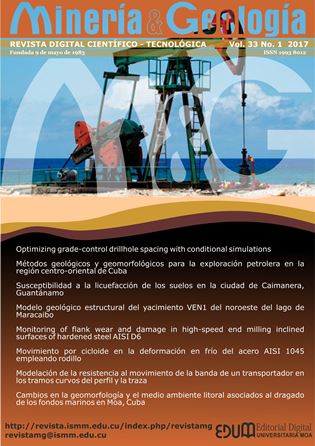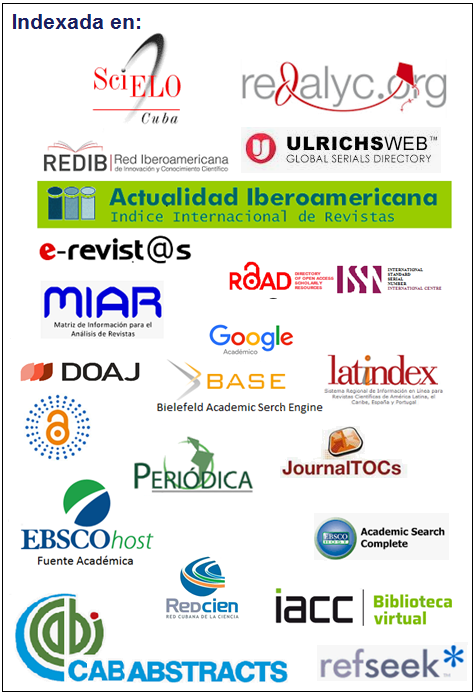Cycloid movement in the cold deformation of steel AISI 1045 using roller
Keywords:
cycloid, plastic deformation, acrylic single roller, stress.Abstract
The stress state of the steel was determined from an experimental design where penetration depth, roller diameter, contact angle and the stresses of contact with deformation forces of 500, 1 500 and 2 500 N were considered as main variables. It is settle down that, as the roller moves through the surface of the material, compression stresses arise which deform the crystal lattice, introducing internal stresses that cause hardening by acrimony.Downloads
References
BOADA, O.; DÍAZ, S. & CAMPOS, Y. 2003: Estudio del estado físico-mecánico de superficies tratadas por deformación plástica superficial. Revista Ingeniería Mecánica 6(2): 53-58.
ALCÁNTARA-BORGES, D.; FERNÁNDEZ-COLUMBIÉ, T. & RODRÍGUEZ-GONZÁLEZ, I. 2008: Comportamiento de las capas superficiales deformadas plásticamente por el desgaste en elementos circulares. Ciencias Holguín XIV(4): 1-4.
FERNÁNDEZ-COLUMBIÉ, T.; FERNÁNDEZ-GUILARTE, E.; RODRÍGUEZ-GONZÁLEZ, I. & ALCÁNTARA-BORGES, D. 2008: Procedimiento para endurecer el acero 45 mediante la deformación plástica con rodillo simple. Ingeniería e Investigación 28(1): 15-21.
FERNÁNDEZ-COLUMBIÉ, T.; RODRÍGUEZ-GONZÁLEZ, I. & ALCÁNTARA-BORGES, D. 2009: Tensión–Deformación durante la deformación plástica superficial con rodillo. Revista de Ingeniería Mecánica 12(3): 13-22.
FERNÁNDEZ-COLUMBIÉ, T.; RODRÍGUEZ-GONZÁLEZ, I. & ALCÁNTARA-BORGES, D. 2010: Variación microestructural del acero AISI 1045 endurecido por rodadura. Minería y Geología 26(3): 65-74.
FERNÁNDEZ-COLUMBIÉ, T.; FERNÁNDEZ-GUILARTE, E.; RODRÍGUEZ-GONZÁLEZ, I. & ALCÁNTARA-BORGES, D. 2011: Evaluación del coeficiente de endurecimiento del acero AISI 1045 deformado por rodillo. Revista Nexo 24(2): 16-26.
FERNÁNDEZ-COLUMBIÉ, T.; FERNÁNDEZ-GUILARTE, E.; RODRÍGUEZ-GONZÁLEZ, I. & ALCÁNTARA-BORGES, D. 2012a: Tensiones de contacto por el Método de Elementos Finitos del acero AISI 1045 endurecido por rodillo. Revista de Metalurgia 48(1): 1-10.
FERNÁNDEZ-COLUMBIÉ, T.; RODRÍGUEZ-GONZÁLEZ, I.; QUINTANA-PUCHOL, R. & GARCÍA-DOMÍNGUEZ, A. 2012b: Determinación de tensiones por rayos x del acero AISI 1045 deformado por rodillo. Revista de Ingeniería Mecánica 15(1): 23-33.
KOROTCISHE. L. 1989: Procesos progresivos en la deformación plástica superficial por rodadura. Mir, Moscú, 53-64.
KUKIELKA, L. 1989: Designating the field areas for the contact of a rotary burnishing element with the rough surface of a part, providing a high-quality product. Journal of Mechanical Working Technology 19(3): 319-356.
MARTYNENKO, O. 2002: The interconnection of strained condition in the area of contact with the kinematics of points of deformed surface points by the rollers plastic deformation of the surfaсe. Proceeding of Fundamental and application problems of machine building technology International Conference, Technology, Tula Technical University, Russia, March 1-September 10.
MORENO, G.; CAPO-SÁNCHEZ, J.; FERNÁNDEZ, T. & AYARDE, D. 2014: La emisión magnética Barkhausen en el acero AISI 1045 deformado plásticamente con rodillo. Revista Cubana de Física 31(1): 19-21.
MURTHY, R. & KOTIVEERACHARI, B. 1981: Burnishing of metallic surfaces a review. Regional Engineering Collage. Precision Engineering USA 3(3): 172-179.
VILLANUEVA, J. Z. 1985: Note on the rough cycloidal slide track. American Journal of Physics 53(5): 490-491.
Published
How to Cite
Issue
Section
- Authors retain copyright and guaranteeing the right magazine to be the first publication of the work as licensed under a Creative Commons Attribution-NonCommercial that allows others to share the work with an acknowledgment of the work's authorship and initial publication in this journal.
- Authors may establish separate supplemental agreements for the exclusive distribution version of the work published in the journal (eg, place it in an institutional repository or publish it in a book), with an acknowledgment of its initial publication in this journal.
- Authors are allowed and recommended to disseminate their work through the Internet (e.g., in institutional telematic archives or on their websites) before and during the submission process, which can produce interesting exchanges and increase citations of the published work. (See The effect of open access)




